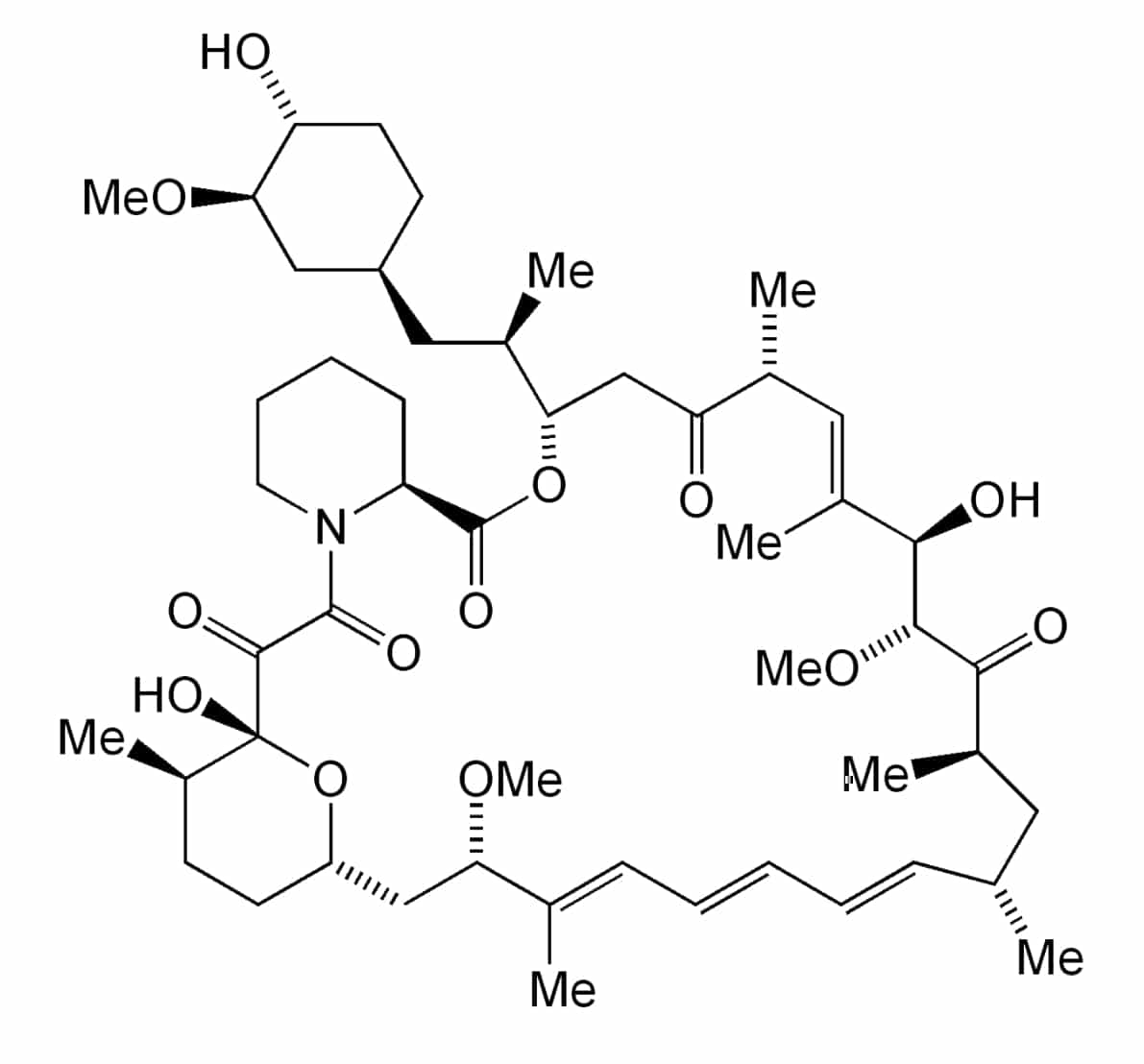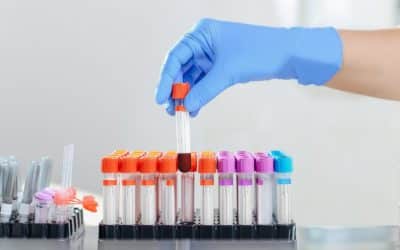
Rapamycin is one of the most promising drugs to extend lifespan and slow aging. In nearly all studies, rapamycin extends lifespan; see below an overview of studies.
Contrary to many other lifespan extending drugs, rapamycin extends lifespan in both males and females in many cases; most other drugs only extend lifespan in females or males, but not both.
Rapamycin seems to extend lifespan more in females though, however, with higher doses this difference between sexes becomes smaller.
One way rapamycin extends lifespan is by increasing autophagy (the digestion of proteins and other waste materials in the cell), but also by improving the epigenome.
How does rapamycin work?
Rapamycin inhibits mTOR (mammalian target of rapamycin). mTOR is a protein found in our cells. It’s a sensor that senses amino acids (and also glucose).
If we for example eat a large steak, then the proteins in the steak are broken down into amino acids in our gut, and these are absorbed in the bloodstream and reach our cells. mTOR senses an increase in amino acids, activating this sensor protein.
When mTOR is activated, it starts all kinds of growth processes in the cell: more proteins are made by the cell (there are after all more amino acids present so they can be used to make proteins), cellular metabolism is revved up, and various repair and maintenance pathways are shut down given there are plenty of energy and building blocks (amino acids) so cells don’t have to go into scarcity mode (which would entail preserving their parts, and better recycling and repairing everything).
One such important maintenance and recycling pathway is autophagy: this is the ability of the cell to break down its own components and materials, including proteins.
mTOR however inhibits autophagy. This is not a good thing, because autophagy clears up protein and other mess that accumulates during aging. The less autophagy, the more proteins and other waste materials accumulate in cells, hindering their proper functioning.
The accumulation of proteins and other cell components plays an important role in various aging-related diseases, such as Alzheimer’s disease (in which amyloid and tau protein accumulate in the brain), aging-related heart failure (in which specific proteins such as desmin accumulate in the heart) hindering its proper functioning, or accumulation of proteins in the blood vessel walls, making them more prone to breaking (e.g. aging-related angiopathy).
Unfortunately, during aging, autophagy declines. This causes proteins and other cellular materials to accumulate.
Rapamycin however, by inhibiting mTOR, increases autophagy, nudging cells to clear up their waste materials that otherwise would accumulate and contribute to aging.
Of course, rapamycin also has various other beneficial effects, such as improving the epigenome (R,R,R), reducing inflammation (R,R) and improving mitochondrial health (R,R).
Rapamycin and lifespan
We see that rapamycin has a decent safety profile in the sense that it does not seem to shorten lifespan; in nearly all studies rapamycin increased lifespan, and in very few studies it had no effect, but in no studies rapamycin shortened lifespan in normal mice, even at high doses.
Some people worry about rapamycin suppressing the immune system too much, increasing the risk of infections. However, as I explain here, rapamycin could actually improve immune health and reduce the risk of infections.
Another common concern is that rapamycin induces insulin resistance and diabetes. However, it’s more complicated than that, as I explain here.
Below you find an overview of scientific studies demonstrating lifespan extension in animals.
Rapamycin lifespan extension studies
| Mouse strain | Age started | Rapa dose | Increase in life span | Reference |
|---|---|---|---|---|
| UM-HET3 | 19 months | 14 ppm* | 9% M–14% F | [6] |
| C57BL/6Nia | 22–24 months | 4 mg/kg i.p.+ | > 100% M | [138] |
| UM-HET3 | 9 months | 14 ppm* | 10% M–18% F | [17] |
| 129/Sv | 2 months | 1.5 mg/kg s.c.^ | 10% F | [40] |
| C57BL/6 | 4, 13, and 20 months | 14 ppm* | 11% M | [79] |
| UM-HET3 | 9 months | 4.7, 14, and 42 ppm* | 3–23% M to 16–26% F | [19] |
| C57BL/6J | 4 months | 14 ppm* | 11% M–16% F | [16] |
| C57BL/6Nia | 19 months | 14 ppm* | 0% M–6% F | [139] |
| 129/Sv × C57BL/6 | 2 months | 14 ppm* | 12% M–21% F | [38] |
| C57BL/6Nia | 20 months |
126 ppm* 8 mg/kg i.p. daily# |
45% M–39% F 61% M–0% F |
[20] |
| C57BL/6J | 20 months | 2 mg/kg i.p.@ | 13% F | [10] |
| UM-HET3 | 9 months | 14 ppm* + metformin* | 23% M–23% F | [140] |
| C57BL/6 × C3H | 20–23 months | 4 mg/kg i.p.++ | 10% M–22%F | [30] |
| UM-HET3 | 9 months | 4.7, 14, and 42 ppm* | 16, 21, 26% F | [131] |
| C57BL/6 | 3 months | 42 ppm* | 58% M and F | [29] |
*Rapamycin given in the diet
^Rapamycin given for 2 weeks and then not given rapamycin for 2 weeks
#Rapamycin given for only 3 months
@Rapamycin given 5 days/week
+Rapamycin given every other day for 6 weeks
++Rapamycin given every other day
Rapamycin lifespan extension cancer studies
In many mice cancer models, rapamycin extends lifespan and survival and leads to reduced tumor growth.
| Mouse strain | Age started | Rapa dose* | Increase in lifespan | Reference |
|---|---|---|---|---|
| Mouse models of cancer | ||||
| Ptet−/− | 1 month | 10 mg/kg/day by gavage | 300% M and F | [42] |
| ApcD716 | 6–14 weeks | 3 and 10 mg/kg/day^ | 140–220% M and F | [33] |
| ApcMin/+ | Not given | 40 mg/kg | 78% M and F | [34] |
| HER-2/neu | 2 months | 1.5 mg/kg s.c.# | 13% F | [40] |
| p53−/− | 2 months | 0.5 mg/kg by gavage@ | 30% M | [39] |
| p53+/− | < 5 months | 1.5 mg/kg in water | 28% M | [37] |
| Rb1+/− | 8–10 weeks | 14 ppm | 14% M–9% F | [43] |
| ApcMin/+ | 50 days | 14 and 42 ppm | 280–440% F | [35] |
| HER-2/neu | 4–5 months | 045 mg/kg s.c.# | 5–7% M and F | [41] |
| p53+/− | 2 months | 14 ppm | 15% M – 17% F | [38] |
| Rag2−/− | 3 months | 14 ppm | 120% M and F | [44] |
| IFN-γ−/− | 5 months | 14 ppm | 34% M and F | [44] |
| Mouse models of diseases other than cancer | ||||
| Lmna−/− | 2 months | 14 ppm and 8 mg/kg i.p. every other day | 23 and 57% M and F | [21] |
| Bmal1−/− | 16 weeks | 0.5 mg/kg in water | 50% M and F | [22] |
| Ndufs4−/− | 20 days | 14 and 378 ppm | 29 and 100% M and F | [24] |
| TK2KI/KI | 15 days | 4 mg/kg in water+ | 60% M and F | [23] |
| BKS-Leprdb | 15 weeks | 14 ppm | 0% M–100% F | [25] |
*Given in diet unless otherwise indicated
^Everolimus given by gavage 5 times a week
#Given 3 times a week for a period of 2 weeks followed by 2-week intervals without rapamycin
@Given 5 days followed by 9-day interval without treatment
+Given to dams at 0.8 mg/kg before weaning




